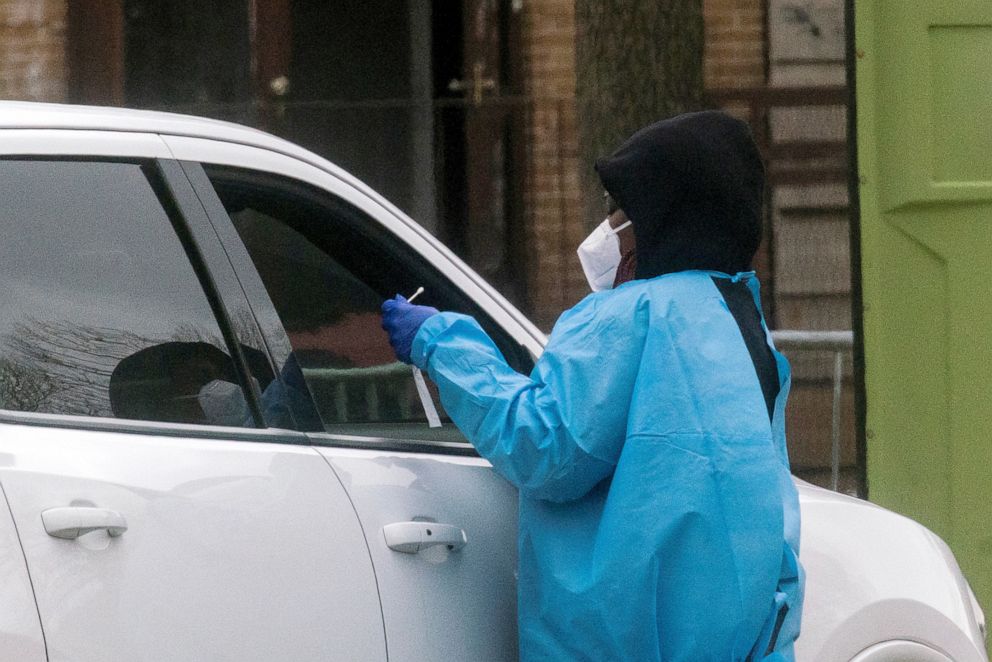US vaccinations are increasing, but what happened to COVID-19 testing?
"I just worry that we've lost that infrastructure," said Dr. Jennifer Nuzzo.
As more Americans get vaccinated, the urgency to get a COVID-19 test is steadily declining despite the Biden administration promising there would be a "wartime undertaking" to increase access, with billions of dollars in investment from U.S. manufacturing companies to develop new COVID-19 tests.
The U.S. has continued a downward trend, with a 30% decrease in the number of daily COVID-19 tests, according to the Johns Hopkins University Coronavirus Resource Center. The U.S. now conducts just over 1 million tests a day after hitting its peak for the year so far on Jan. 15 with 2.3 million tests.
With roughly 20% of the U.S. population fully vaccinated against the coronavirus according to the Centers for Disease Control and Prevention, the nation still remains months away from vaccine availability being widespread in all regions of the country.
"Even if you take the really optimistic view that we're not missing anything right now, I just worry that we've lost that infrastructure," said Dr. Jennifer Nuzzo, lead epidemiologist for the Johns Hopkins Coronavirus Resource Center. "If we suddenly need to surge testing again, it's not clear to me how we would do it given that a number of the testing sites have turned over and are focused on vaccines."

COVID-19 testing has been a highly politicized issue from the pandemic's onset, with the first set of tests rolling out slowly and often highlighting a racial disparity within the U.S. health care system's infrastructure.
But now with the focus almost entirely on vaccinations and more states gradually starting to lift coronavirus restrictions, some medical experts see an immediate challenge in reversing the testing downturn.
"My assessment of what's going on out there is that COVID fatigue has had its influence on testing. There is a sense generally in the community that the proverbial light is getting brighter every day," said Dr. William Shaffner, a professor of infectious diseases at Vanderbilt University Medical Center. "That notion is out there in abundance, contrary to public health concerns, but I think it has contributed to a reduction in testing, which is unfortunate."
Testing still remains the surest way to track new infections with a continued nationwide increase in COVID-19 cases, and new, more contagious viral strains complicating the federal pandemic response.
The CDC recently declared the B.1.1.7 coronavirus strain, otherwise known as the U.K. variant, as the most predominant viral strain in the nation.
"We now have variants out there. And we need to know where the residual areas of viral spread are," said Shaffner. "The only way you can find that is to determine where the new cases are -- and you determine where the new cases are by testing."
The idea of consistent coronavirus testing as the U.S. vaccination rate increases seems to resonate more with the leaders of universities, school districts, private sector organizations and government agencies. Such organizations are rolling out spring pilot programs to explore how they might return students and employees to their buildings in greater number this fall.
The U.S. Food and Drug Administration partnered with Labcorp in March to implement a voluntary COVID-19 testing program for agency employees and contractors doing in-person work at government buildings or elsewhere.
Approximately 3,000 polymerase chain reaction, or PCR, tests a month are expected to be provided to FDA employees over the course of the program's year-long contract. Some FDA personnel inspect vaccine manufacturing facilities and food work places, making coronavirus testing a critical component of the agency's return to work.
The test -- the Pixel by Labcorp -- is designed for users taking a swab of their nostril and then sticking it into a solution. Users can expect test results within 48 hours after the lab processes that sample.
"This is adding one more way for them to access the test, it doesn't replace other opportunities to get tested where appropriate," said Dr. Brian Caveney, chief medical officer at Labcorp and president of Labcorp Diagnostics. "We don't have any idea how many of the tests will actually be used. It's just one of many purposes."

As U.S. companies and business grapple with how to implement effective testing regimes, the U.K. is taking their plan for rapid testing a step further, offering it to each of their citizens, at least twice a week.
In the U.S., the Biden administration laid out a $50 billion plan that would boost the nation's testing capacity through the increase of rapid antigen tests, testing centers, expand lab-test processing, provide uniform guidance for in-school COVID testing and establish a national pandemic testing board.
Ten billion dollars was allocated for testing in schools from the recently passed stimulus package aimed at helping districts confront the task of getting more children back into the classrooms safely.
The administration also announced a $230 million deal with Ellume, an Australian digital diagnostics company, to provide 8.5 million over-the-counter at-home tests. Ellume plans to produce 100,000 testing kits per month through July and ramp up to 19 million a month by the end of the year.
But despite the federal investment in testing and retail stores purchasing millions of rapid tests in bulk from U.S. test manufacturing companies, those efforts still haven't paid off with higher daily COVID testing numbers.
A Biden administration official, who spoke on condition of anonymity, told ABC News there has been no reduction in urgency regarding federal and state testing programs aimed at providing Americans greater access to COVID-19 testing.
The official also said the goal is now to ensure that Americans are aware and can easily access the various testing options available to them.
But still, some doctors and health care workers struggle to see how the Biden administration's ambitious plans for testing is meeting its promise with daily test numbers down.
"I haven't yet seen it realized on the ground, in the field," said Schaffner. "But any kind of structure and support one can give toward testing to stabilize that and to have people working in testing programs that are commuted over time is important so this is not a one-shot deal."




